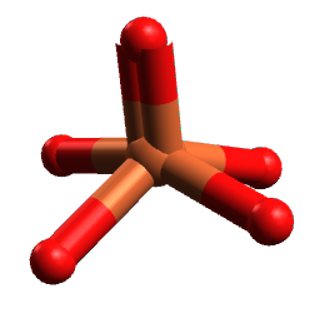Chemistry:Alpha-oxygen

| |
| Names | |
|---|---|
| Other names
Alpha-O, α-O
| |
Except where otherwise noted, data are given for materials in their standard state (at 25 °C [77 °F], 100 kPa). | |
| Infobox references | |
Alpha-oxygen (α-O) is a reactive oxygen species formed from an oxygen-atom abstraction (OAT) from nitrous oxide (N2O) by alpha-iron (α-Fe) catalysts. The latter is defined as a high spin (S=2) divalent iron(II) ion in a constrained square planar coordination with an accessible axial coordination position. The stabilization of α-O requires structural strain on the equatorial ligand field to maintain the reactive oxygen atom in the axial position and it is this forced geometry, similar to the 'entatic state' known in metalloproteins, that lies at the basis of its reactivity in inert C-H bond activation.[1]
The alpha-oxygen site was first discovered and named in 1990 by researchers from the Boreskov Institute of Catalysis in the ZSM-5 zeolite,[2][3] and was later described in detail by researchers from Stanford University and KU Leuven in the beta zeolite.[1][4][5]
See also
References
- ↑ 1.0 1.1 "The active site of low-temperature methane hydroxylation in iron-containing zeolites". Nature 536 (7616): 317–21. August 2016. doi:10.1038/nature19059. PMID 27535535. Bibcode: 2016Natur.536..317S.
- ↑ "The role of iron in N2O decomposition on ZSM-5 zeolite and reactivity of the surface oxygen formed". Journal of Molecular Catalysis 61 (1): 85–97. July 1990. doi:10.1016/0304-5102(90)85197-P.
- ↑ "Catalytic Properties of ZSM-5 Zeolites in N2O Decomposition: The Role of Iron". Journal of Catalysis 139 (2): 435–443. February 1993. doi:10.1006/jcat.1993.1038.
- ↑ "Identification of α-Fe in High-Silica Zeolites on the Basis of ab Initio Electronic Structure Calculations" (in EN). Inorganic Chemistry 56 (17): 10681–10690. September 2017. doi:10.1021/acs.inorgchem.7b01653. PMID 28836775. https://lirias.kuleuven.be/handle/123456789/592553.
- ↑ "Structural characterization of a non-heme iron active site in zeolites that hydroxylates methane". Proceedings of the National Academy of Sciences of the United States of America 115 (18): 4565–4570. May 2018. doi:10.1073/pnas.1721717115. PMID 29610304.

